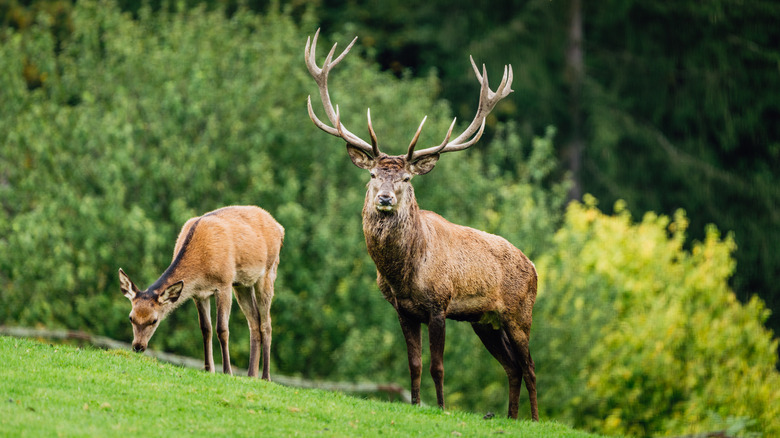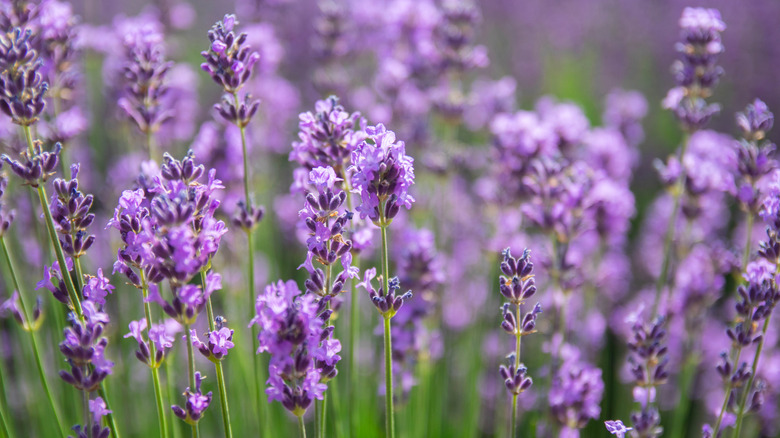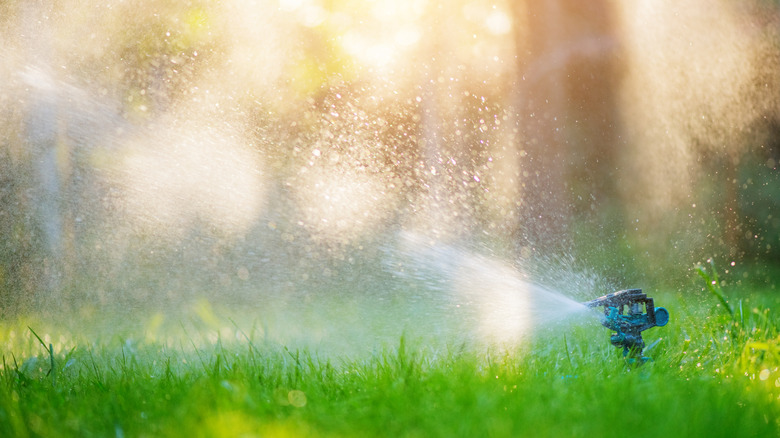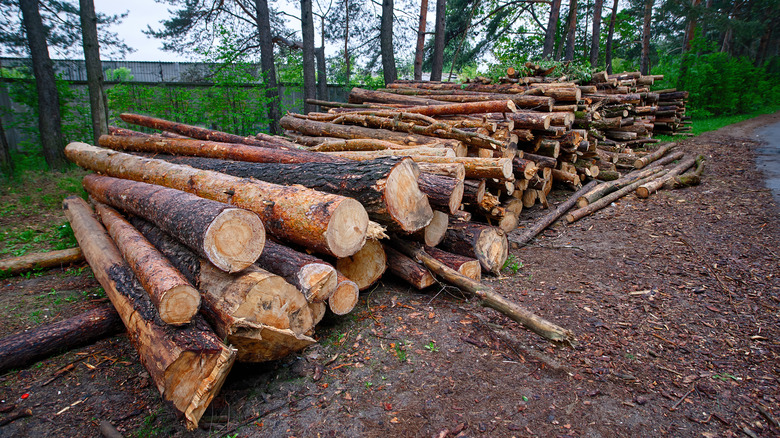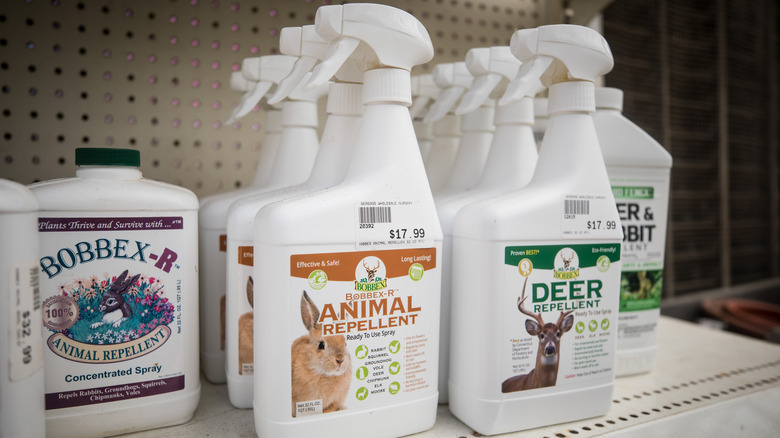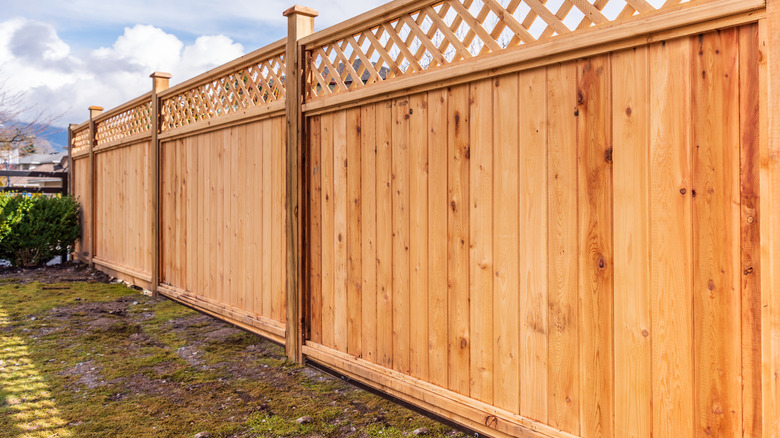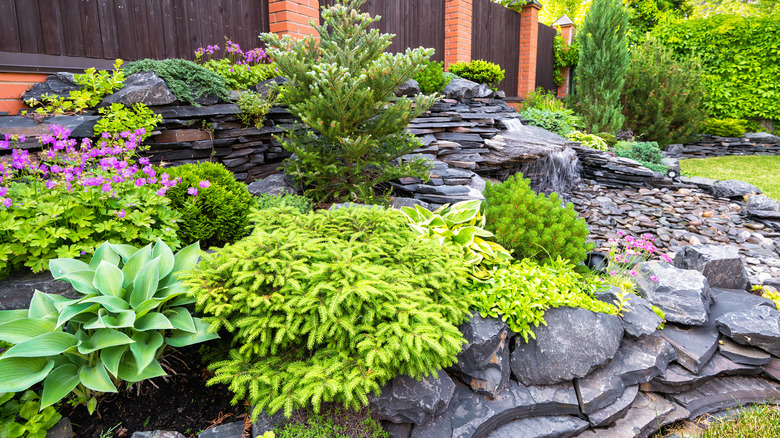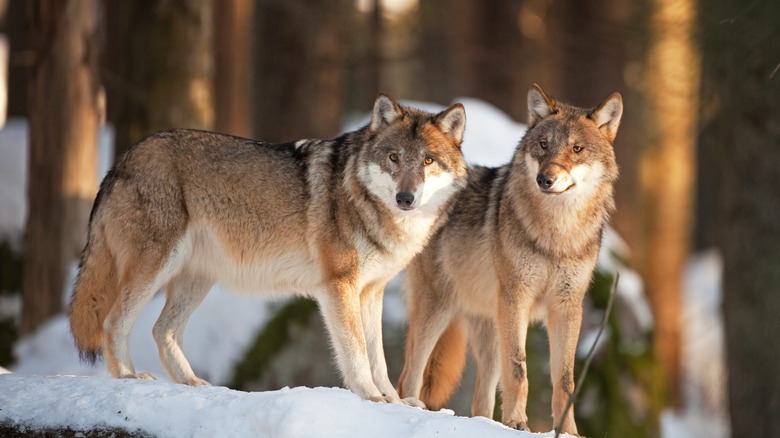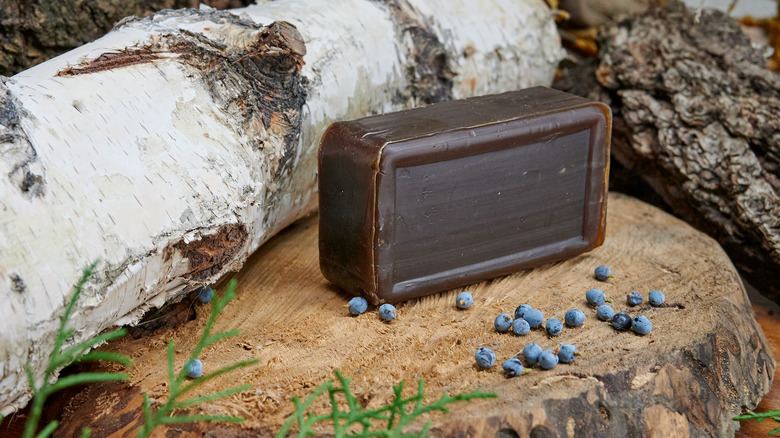9 Best Ways To Keep Deer Out Of Your Yard
The United States Department of Agriculture says that deer are critical in keeping the ecosystem balanced. Not only do they feed on plants and fruit to keep everything trimmed down, but they are also a food source for wolves and coyotes. They're beautiful and typically harmless creatures, and no matter how many times we see one, we all have the tendency to get excited when we spot a deer. However, they don't just stay out in the forests and parks, they can sometimes make their way into our yards and gardens.
Unfortunately, deer can cause various issues if they take an interest in your yard, Stream Line Lawn & Landscape says. Not only will they eat everything in sight, leaving your lawn barren, but they can also spread parasites and diseases and put your family and pets at risk. An interesting fact is deer droppings can actually burn your lawn; the high levels of nitrogen cause this to happen, and it's very hard to clean up as they leave little traces everywhere. If these are just a few of the irritating issues you've been dealing with, continue reading for the nine best ways to keep out your unwelcome guests.
Stop feeding them
One of the major reasons as to why you're having a deer problem in the first place is probably because you have tasty plants planted everywhere. This Old House says plants deer are most attracted to are English ivy, lettuces, beans, peas, hostas, impatiens, and pansies — they'll also snack on the occasional fruit tree. This is especially an issue during the spring because does are trying to fill up their gut as they take care of their infants and try to gain back the weight they lost during the winter.
For those who don't want to get rid of some of their most favorite plants, it's advised to keep them close to the house — the deer won't be as confident coming up to a human-populated home. You can also plant flowers that deer don't like as a barrier, such as mint and lavender. The strong smell of these plants will be distasteful to their sensitive noses.
Sprinkler party
No one likes an unexpected spray to the face. Havahart says an effective way to keep deer out is by installing a sprinkler system that is used specifically to scare away unwanted animals from your yard. There are sprinkler systems that are able to activate as soon as they read movement through its infrared technology, and it works 24/7. Once a deer jumps into your yard, this sprinkler system will turn on and give them a good spray to scare them away. This is a good option for those who would like to implement an anti-deer system without actually hurting them.
You can either purchase this system or create your own with your existing sprinkler system, according to Angi. They connected their sprinkler system with a motion sensor, with a photocell built-in, so the sprinkler system doesn't run during the day. It is not powered by batteries but instead is powered with 120 volts of electricity from the house.
Climbing obstacles
Deer do not like to climb, according to Havahart. So a way to keep them off your lawn is by making it very difficult for them to enter in the first place. You can do this by creating sunken beds, terraces, and stacks of chopped wood to keep the deer away. This is because deer are too scared to jump or climb, so they will probably go to a more accessible yard. This is also good news for your precious plants. If your deck or porch has steps, you can keep potted plants on them as the deer will most likely not walk up the steps.
While you create your medieval trenches, it would also be a good idea to also take the time to properly take care of your landscape. Trim down any plants that may be a good hiding spot for a deer, and this will discourage them from staying in a yard where they are out in the open.
Use repellent spray
Angi says repellent spray is a useful tool to keep your beautiful flowers protected from deer. Repellent used to ward off deer typically needs to be sprayed on plants every two weeks in the winter and once a month in the summer. You can find deer repellent spray that is made of natural ingredients with pleasant smells, such as peppermint. The one major upside is that it also does not easily wash off plants, however, you must remember to spray your plants a couple of times a month throughout the year, otherwise, they will be at risk of being eaten by deer.
There are different types of deer repellents, according to Organic Plant Care. There are repellents that create a bad smell or taste for deer, but it's advised to use the bad-smelling ones because a deer's nose will pick that up faster. There are also other repellents made with predator urine, such as coyotes, to scare deer off by perpetuating their possible presence.
Build a fence
To really ensure deer do not get into your yard, Gardener's Oasis suggests building a fence. The height of the fence should be 8 to 12-feet high to make sure the deer are unable to jump over. A fun way to make the fence feel higher is by placing planters with deer repellent flowers across the top to really ward them off. If your fence is see-through, the fence will probably need to be closer to the 12-foot height as deer will be tempted to jump over if they can see what's on the other side.
If you don't want a super high fence, either build a full or double fence. If your fence is on the shorter side, you can plant trees and shrubs along the inside. This will prevent them from jumping if they cannot see an open area to land on the other side.
Rock garden border
Gardener's Oasis also advises creating a rock garden to keep deer away. The most successful way of doing this is making sure all the rocks are different sizes to ensure the area is very bumpy and not flat enough for the deer to walk on.
Creating a rock garden is pretty simple, and the end result is a cute aesthetic. Backyard Boss says the first step is to clear off the area of land where you are planning on building your rock garden. Once you've done that, you should spend time designing the overall layout. You may think that you're just putting a bunch of rocks and plants together, but the overall design will highly depend on your artful vision. Next is to add your first layer of rocks, which you can purchase at a gardening store, or do some research online and contact a few shops if you have some specific stones in mind. Your rock garden is then ready for some sandy soil to be placed and packed down before placing down your second layer of larger rocks. Lastly — and the most fun part — is adding the flowers. This will be an easier process for you if you pick plants with similar growing requirements.
Let your dogs inner wolf out
Dogs are a man's best friend in many ways; one way is by protecting their homes from enemies. Your dog, no matter the size, can scare off deer as long as they have a strong bark, according to Gardener's Oasis. However, this can only work if your dog is able to get close to where the deer usually are in your garden. Deer are smart creatures and are capable of learning that your dog is unable to get close to them if your dog is tied to a tether. Mi Dog Guide says that if the scent of your dog is all over your yard, this will also make deer feel scared and drive them away.
However, use this tactic with caution, especially if you have a smaller dog. Deer are definitely capable of trampling and running over your pup. If your dog is not properly trained, maybe skip this step.
Bar of soap
This may be an interesting look for your yard, but HGTV says hanging bars of soap around your yard in trees and bushes will keep deer away. If you don't have any trees, you can attach the bars of soap to stakes and place them 10 to 15-feet apart around your yard. This deer repellent method is the quickest and most effective, according to SFGate. Apparently, the strong scent has deers believing there are predators in the area, evidently keeping them away.
When tying bars of soap around your yard, make sure there is one soap per plant. A cheap and quick way to hang them is by dropping a bar of soap into a nylon stocking. However, make sure the soap is tied about 6 to 10 feet off the ground to ensure that animals, such as raccoons, aren't tempted to rip them apart. You can also drill a hole through the bar of soap and tie a string through it as an effective hanging method.
Make a natural repellent at home
Of course, we can't always install a sprinkler system or build a fence, and sometimes we just don't want to use store-bought chemicals. In that case, you can make your own homemade natural deer repellent with items already sitting in your kitchen cabinet or pantry. Cinnamon is an important element of deer repellent because it's a scent they really don't like. Cinnamon sticks or crushed powder may work, but for the strongest spray, you'll want to get your hands on cinnamon essential oil. Combine cinnamon oil with clove and mint essential oils — two other scents trusted to keep deer at bay — and mix them with vinegar, a splash of cooking oil, and a squirt of dish soap. Mix it up all in a spray bottle and apply it to plants around the yard.
There are lots of other scents that deer dislike, so even if you're fresh out of cinnamon oil, you'll be able to concoct something that will work. Lavender, garlic, sage, thyme, and rosemary can all go in the spray bottle. And for extra protection next season, consider starting an herb garden full of everything deer can't stand. It'll really get the job done and leave you with edible plants the bucks and does are sure to pass up.
